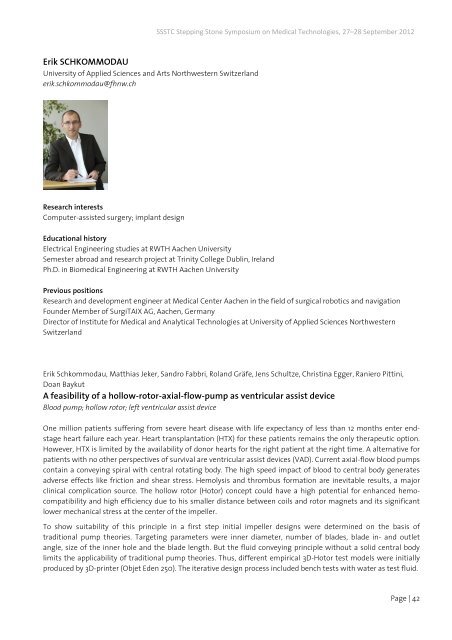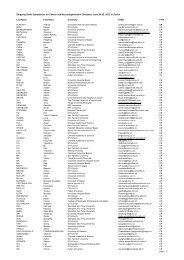Stepping Stone Symposia Conference on Medical Technology ...
Stepping Stone Symposia Conference on Medical Technology ...
Stepping Stone Symposia Conference on Medical Technology ...
Create successful ePaper yourself
Turn your PDF publications into a flip-book with our unique Google optimized e-Paper software.
Erik SCHKOMMODAU<br />
University of Applied Sciences and Arts Northwestern Switzerland<br />
erik.schkommodau@fhnw.ch<br />
Research interests<br />
Computer-assisted surgery; implant design<br />
SSSTC <str<strong>on</strong>g>Stepping</str<strong>on</strong>g> <str<strong>on</strong>g>St<strong>on</strong>e</str<strong>on</strong>g> Symposium <strong>on</strong> <strong>Medical</strong> Technologies, 27–28 September 2012<br />
Educati<strong>on</strong>al history<br />
Electrical Engineering studies at RWTH Aachen University<br />
Semester abroad and research project at Trinity College Dublin, Ireland<br />
Ph.D. in Biomedical Engineering at RWTH Aachen University<br />
Previous positi<strong>on</strong>s<br />
Research and development engineer at <strong>Medical</strong> Center Aachen in the field of surgical robotics and navigati<strong>on</strong><br />
Founder Member of SurgiTAIX AG, Aachen, Germany<br />
Director of Institute for <strong>Medical</strong> and Analytical Technologies at University of Applied Sciences Northwestern<br />
Switzerland<br />
Erik Schkommodau, Matthias Jeker, Sandro Fabbri, Roland Gräfe, Jens Schultze, Christina Egger, Raniero Pittini,<br />
Doan Baykut<br />
A feasibility of a hollow-rotor-axial-flow-pump as ventricular assist device<br />
Blood pump; hollow rotor; left ventricular assist device<br />
One milli<strong>on</strong> patients suffering from severe heart disease with life expectancy of less than 12 m<strong>on</strong>ths enter endstage<br />
heart failure each year. Heart transplantati<strong>on</strong> (HTX) for these patients remains the <strong>on</strong>ly therapeutic opti<strong>on</strong>.<br />
However, HTX is limited by the availability of d<strong>on</strong>or hearts for the right patient at the right time. A alternative for<br />
patients with no other perspectives of survival are ventricular assist devices (VAD). Current axial-flow blood pumps<br />
c<strong>on</strong>tain a c<strong>on</strong>veying spiral with central rotating body. The high speed impact of blood to central body generates<br />
adverse effects like fricti<strong>on</strong> and shear stress. Hemolysis and thrombus formati<strong>on</strong> are inevitable results, a major<br />
clinical complicati<strong>on</strong> source. The hollow rotor (Hotor) c<strong>on</strong>cept could have a high potential for enhanced hemocompatibility<br />
and high efficiency due to his smaller distance between coils and rotor magnets and its significant<br />
lower mechanical stress at the center of the impeller.<br />
To show suitability of this principle in a first step initial impeller designs were determined <strong>on</strong> the basis of<br />
traditi<strong>on</strong>al pump theories. Targeting parameters were inner diameter, number of blades, blade in- and outlet<br />
angle, size of the inner hole and the blade length. But the fluid c<strong>on</strong>veying principle without a solid central body<br />
limits the applicability of traditi<strong>on</strong>al pump theories. Thus, different empirical 3D-Hotor test models were initially<br />
produced by 3D-printer (Objet Eden 250). The iterative design process included bench tests with water as test fluid.<br />
Page | 42



